


© YB75
Nummus - Licinius I IOVI CONSERVATORI; Siscia
| Bronze | 3 g | 20 mm |
| Issuer | Rome › Roman Empire (27 BC - 395 AD) |
|---|---|
| Emperor | Licinius I (308-324) |
| Type | Standard circulation coin |
| Years | 315-316 |
| Value | Nummus (1⁄7200) |
| Currency | Solidus, Reform of Constantine (AD 310/324 – 395) |
| Composition | Bronze |
| Weight | 3 g |
| Diameter | 20 mm |
| Shape | Round (irregular) |
| Technique | Hammered |
| Orientation | Coin alignment ↑↓ |
| Demonetized | Yes |
| Updated | 2024-10-05 |
| Numista | N#78768 |
|---|---|
| Rarity index | 67% |
Reverse
Jupiter Nicephore naked, standing left, the coat on the shoulder, holding a globe of the Nicephore right hand and a scepter along the left ; an eagle in left field, turning his head to the right
Scripts: Latin, Greek
Lettering:
IOVI CONSERVATORI
Γ (gamma)
.SIS.
Translation: “Iovi Conservatori”
Edge
Plain
Comment
Light weight. A single ribbon visible at the ball endThis type is made before the reform of 313 which lowered the weight of the follis to 1/96th of a pound (3.38 g). Before this date, bronzes were cut to 1/72th of a pound (4.51 g) or 1/84th of a pound (3.87 g). This type of bronze is struck before the death of Maximin II. The year 313 would see a triple lowering of the nummus passing successively from 1/72 L (4,51 g) to 1/84 L (3,87 g), finally to 1/96 L (3,38 g).
Interesting fact
One interesting fact about this coin is that it features an image of the Roman god Jupiter on one side, and the emperor Licinius I on the other. This coin was minted during Licinius' reign as emperor, which lasted from 308 to 324 AD. The image of Jupiter on the coin is significant because it highlights the importance of Roman mythology and religion during this time period. Additionally, the fact that the coin was made of bronze, a relatively inexpensive metal, suggests that it was intended for widespread circulation and use in everyday transactions.



